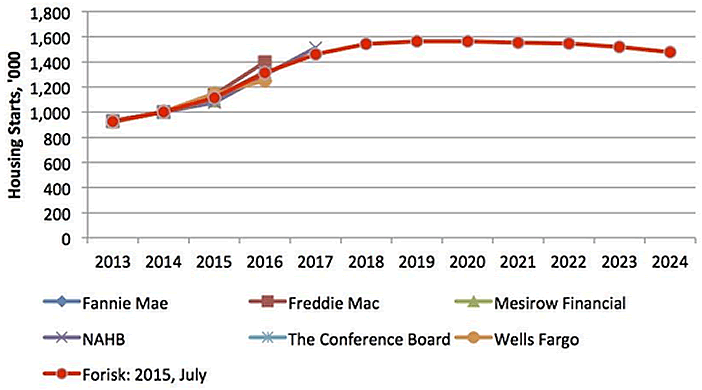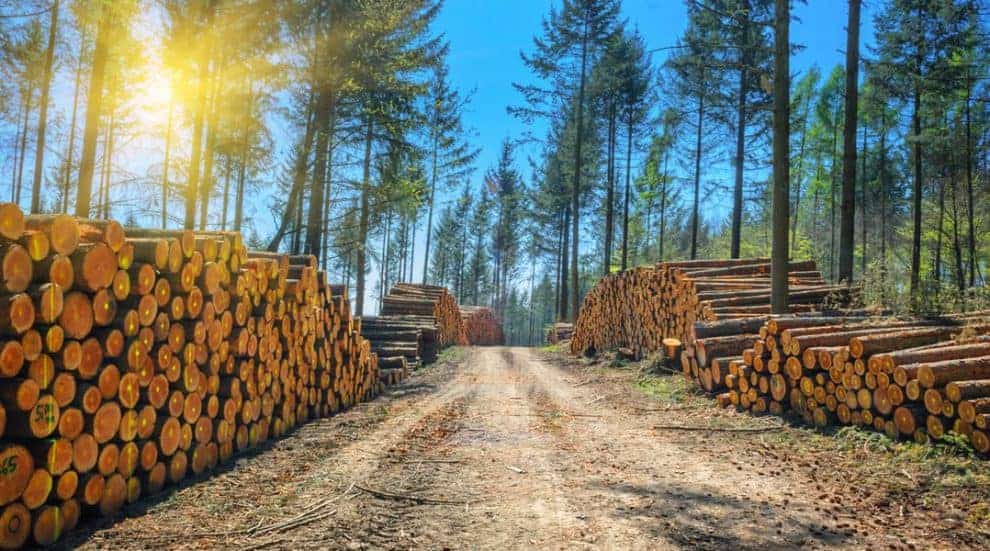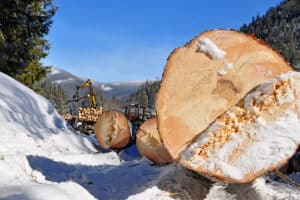Each quarter, when updating the Forisk Research Quarterly (FRQ) forecast models, our team goes through an exercise that combines spring-cleaning, transcendental meditation, and changing the oil in a trusted version of the Family Roadster. Through a systematic process of getting organized, refreshing core research and updating data sets, we generate insights and projections to test and apply to local timber and wood markets. Core findings help explain why the U.S. continues to attract capital investments for manufacturing projects and timberland. This article includes excerpts from the Q3 2015 FRQ research effort:
Housing Markets
For 2015, Forisk projects growth of 11.3% over 2014. Forisk’s Housing Starts Outlook combines independent forecasts from professionals in the housing industry. Currently, these include Fannie Mae, Freddie Mac, Mesirow Financial, the National Association of Home Builders (NAHB), The Conference Board, and Wells Fargo. Forisk projects 2015 housing starts of 1.11 million. The Base Case peaks at 1.57 million housing starts in 2019 before returning to a long-term trend approaching 1.51 million.
Forisk Research Quarterly (FRQ) Q3 2015 US Housing Starts Outlook, Base Case

U.S. Pulp and Paper Industry
How does the U.S. paper and paperboard industry, a sector that continues to attract capital investments, look moving forward? While total U.S. paper and paperboard production has declined, results vary across product categories as profitable categories continue to grow. Over the past 20 years, total paper and paperboard production declined 0.9% annually while subsectors in (1) household and sanitary paper production, and (2) paperboard had compound annual growth rates of 0.9% and 3.8%. Newsprint has shown the greatest decline, but it only accounts for 3% of total production today.
To update projections of paper and paperboard products in the U.S., we again worked with Dr. Jack Lutz of the Forest Research Group. Key findings from our 2015 research include: (1) reduced demand for pulpwood from projected declines in newsprint and writing paper production is offset by projected increases in paperboard production; (2) we use less paper per dollar of GDP; however, this does not mean we use less paper; (3) projections indicate that total U.S. paper use increases slightly. Paper production inches up as growth in paperboard and packaging offsets declines in newsprint and printing and writing paper.
Forest Supplies
How do housing markets affect timber supplies in local markets? In research we conduced with Dr. Bob Abt at N.C. State, we explored the relationship between housing starts and timber supplies for the U.S. South over the next 25 years. We compared a “Base” Case, which uses Forisk’s Base Housing Outlook cited earlier in this article, to a “Low” Case that assumes 10% less pine grade demand in the South. The Low Case equates to ~2.6 million fewer housing starts and ~112 million fewer tons of pine grade harvested between 2015 and 2024 than in the Base Case.
What did we learn? First, pine grade supplies in the South increase in both forecast scenarios, beyond levels seen in recent history. Higher grade demand in the Base Case results in inventories that are 40% higher in 25 years than current inventories. The Low Case results in inventories that are 48% higher than current inventories by 2040. How does this relate to what happened during the recession?
In the 2000s, the South averaged 15 years of pine grade inventory on the stump (inventory relative to removals). The recession reduced grade demand, which led to reduced harvesting and increased inventories. As a result, the years of “relative” inventory increased. Projections indicate that the South will average 19 years in the Base Case (21 years in Low Case). The recession effectively re-set the “normal” baseline relationship of supplies to removals in the South.
While the story for pulpwood is a bit different, the overall finding reinforces how the forest we have today drives the first 5 to 10 years of any supply projection. Acres cycling through harvesting and replanting form the new supply of pulpwood and sawtimber. And, in short, we have a lot of wood and it continues to accumulate.
Overall, the findings from assessing all U.S. forest regions and end product markets confirm the health and diversity of the timber and wood products sector. Base demand from housing, lumber and other building products continues to steadily increase. The strength of this demand is supported by its diversity with markets in pulp, paper, energy and exports. Also, the U.S., especially the South, has ample and accumulating forest supplies, regardless what happens with housing markets over the next 20 years.
This content may not be used or reproduced in any manner whatsoever, in part or in whole, without written permission of LANDTHINK. Use of this content without permission is a violation of federal copyright law. The articles, posts, comments, opinions and information provided by LANDTHINK are for informational and research purposes only and DOES NOT substitute or coincide with the advice of an attorney, accountant, real estate broker or any other licensed real estate professional. LANDTHINK strongly advises visitors and readers to seek their own professional guidance and advice related to buying, investing in or selling real estate.










Add Comment